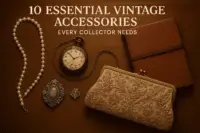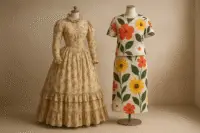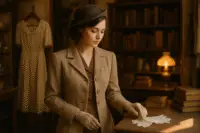Alabaster – Pure white with subtle cream undertones, used in luxury vintage textiles.
Alice Blue – Pale grayish-blue named after Alice Roosevelt Longworth, popular in early 1900s fashion.
Amber – Warm golden-yellow with brown undertones, popular in 1970s bohemian jewelry and accessories.
Antique White – Cream with yellow undertones, popular in vintage wedding dresses.
Apricot – A warm, peachy-orange hue popular in 1920s and 1970s fashion, often used in evening wear and lingerie.
Aqua – Light blue-green, a popular 1950s pastel and 1980s Miami Vice-inspired color.
Ash – Pale gray, commonly referenced in 1920s sophisticated daywear.
Ash Rose – Muted pink with gray undertones, favored in 1920s and 1950s sophisticated daywear.
Aubergine – Deep purple-brown resembling eggplant skin, favored for sophisticated 1940s and 1980s garments.
Avocado – Yellowish-green shade that defined 1970s home and fashion color palettes, particularly in casual wear.
Azure – Clear, bright blue reminiscent of cloudless skies, popular in 1960s mod fashion.
Baby Blue – Very pale blue, signature color in Christian Dior’s 1947 “New Look” collection.
Baby Pink – Very pale pink, extremely popular in 1950s feminine fashion.
Bar Suit Gray – Sophisticated gray from Dior’s iconic 1947 Bar suit, defining post-war elegance.
Beige – Neutral tan-brown, a wardrobe staple across all vintage periods, particularly in 1920s sportswear.
Bisque – Pale orange-pink, popular in 1950s feminine undergarments and lingerie.
Black – The ultimate classic, essential in every era from Victorian mourning dress to 1960s mod fashion.
Blush – Soft pink tone popular in 1950s feminine fashion and 1980s romantic styles.
Bone – Off-white with gray undertones, a practical neutral across all vintage periods.
Brick – Deep red-orange resembling fired clay, common in 1970s earth-toned fashion.
Bronze – Metallic brown with golden undertones, popular in 1920s evening wear and 1970s metallics trend.
Brown – Rich earth tone, particularly prominent in 1970s fashion across all garment types.
Buff – Light yellowish-brown, commonly used in 1940s practical wear.
Burgundy – Deep red-purple wine color, a classic choice for formal wear across all vintage periods.
Burnt Orange – Deep, muted orange popular in 1970s autumn palettes and bohemian fashion.
Burnt Sienna – Warm reddish-brown, frequently used in 1970s earth-toned collections.
Camel – Rich tan inspired by camel hair coats, a sophisticated neutral in 1920s and 1970s fashion.
Canary Yellow – Bright, pure yellow popular in 1960s mod fashion and summer collections.
Caramel – Medium brown with golden undertones, popular in 1970s leather goods.
Celadon – Pale gray-green inspired by Chinese ceramics, popular in 1920s and 1950s sophisticated garments.
Celery – Pale yellow-green, fashionable in 1970s natural color palettes.
Cerise – Deep pink-red, a vibrant choice in 1960s and 1980s fashion.
Cerulean – Deep sky blue, favored in 1960s mod fashion and summer collections.
Champagne – Pale golden beige, a popular choice for 1920s evening wear and wedding dresses.
Chartreuse – Electric yellow-green that gained popularity in 1960s mod fashion and 1980s statement pieces.
Chestnut – Rich reddish-brown, popular for autumn collections across decades.
Chocolate – Rich dark brown, a staple neutral in 1940s wartime fashion and 1970s earth tones.
Cinnamon – Warm reddish-brown spice tone, popular in 1970s bohemian and earth-toned fashion.
Citron – Bright yellow-green, used in 1960s psychedelic and 1970s bold fashion.
Claret – Deep red-purple wine color, synonymous with burgundy in formal wear.
Cobalt – Intense deep blue, a sophisticated choice for evening wear across vintage periods.
Coffee – Medium brown, a versatile neutral particularly popular in 1970s.
Copper – Metallic reddish-brown, popular in 1970s metallics and Art Deco accessories.
Coral – Warm pink-orange popular in 1950s resort wear and summer fashions.
Cranberry – Deep red with purple undertones, popular in autumn vintage fashion.
Cream – Off-white with warm undertones, a classic alternative to pure white across all eras.
Crimson – Deep, true red, a dramatic choice for evening wear throughout vintage fashion history.
Denim Blue – Medium blue characteristic of denim fabric, a casual wardrobe staple.
Dusty Blue – Muted blue with gray undertones, popular in romantic and vintage-inspired fashion.
Dusty Pink – Muted pink with gray undertones, favored in romantic and feminine styles.
Dusty Rose – Muted pink with gray undertones, popular in 1920s and 1980s romantic fashion.
Ecru – Unbleached beige-tan, a natural choice in 1920s and 1970s fashion.
Electric Blue – Brilliant bright blue, popular in 1980s fashion and high-energy aesthetics.
Emerald – Rich, jewel-toned green, a luxury color choice across all vintage periods.
Forest Green – Deep, dark green, popular in outdoor and sportswear across eras.
Fuchsia – Vivid purplish-pink, particularly popular in 1980s bold fashion statements.
Garnet – Deep red with brown undertones, a sophisticated jewel tone choice.
Gold – Metallic yellow, essential in 1920s glamour and 1970s metallics trend.
Goldenrod – Bright yellow with brown undertones, popular in 1970s earth palettes.
Gray – Neutral tone ranging from light to charcoal, a sophisticated choice across all eras.
Gunmetal – Dark gray with metallic finish, popular in 1920s evening accessories.
Harvest Gold – Warm, muted yellow-orange that defined 1970s color palettes.
Heather – Mixed purple-gray, commonly used in 1920s and 1970s knitwear.
Hot Pink – Vibrant bright pink, popular in 1980s fashion and club culture.
Hunter Green – Deep, dark green, a classic choice for sportswear and autumn fashion.
Indigo – Deep blue-purple, traditional dye color popular across all vintage periods.
International Klein Blue – Ultramarine blue developed by artist Yves Klein in 1960, influential in fashion.
Ivory – Creamy off-white, a popular alternative to pure white in wedding and formal wear.
Ivory Coast – Warm cream with yellow undertones, luxury textile color choice.
Jade – Medium green with blue undertones, popular in 1920s orientalist fashion trends.
Jasmine – Pale yellow, popular in 1950s feminine fashion and summer wear.
Kelly Green – Bright, clear green, particularly popular in 1960s mod fashion.
Khaki – Light brown-green, originally military, adopted into 1940s utility fashion.
Lapis – Deep blue with purple undertones, inspired by the precious stone.
Lavender – Pale purple, a feminine choice popular in 1950s and 1970s fashion.
Le Smoking Black – Deep black from Saint Laurent’s iconic 1966 tuxedo collection for women.
Lemon Yellow – Bright, clear yellow, popular in 1960s mod and 1980s bold fashion.
Lilac – Light purple with pink undertones, favored in 1950s feminine and 1970s romantic styles.
Lime – Bright yellow-green, popular in 1960s mod and 1980s neon fashion.
Magenta – Vivid purplish-red, popular in 1960s psychedelic and 1980s power dressing.
Mahogany – Deep reddish-brown, commonly used in 1940s and 1970s fashion.
Malachite – Deep green with blue undertones, inspired by the mineral.
Marigold – Bright orange-yellow named after the flower, popular in 1970s fashion.
Maroon – Dark red-brown, a sophisticated choice for formal wear across vintage periods.
Mauve – Dusty purple-pink, particularly fashionable in 1890s and revived in 1970s.
Midnight Blue – Very dark blue, a formal alternative to black in evening wear.
Mint – Light green inspired by the herb, popular in 1950s pastel collections.
Mint Green – Pale, cool green, popular in 1950s pastel palettes and summer fashion.
Mondrian Blue – Clear blue from YSL’s geometric Mondrian-inspired dresses.
Mondrian Red – Pure red featured in Yves Saint Laurent’s 1965 Mondrian collection.
Mondrian Yellow – Bright yellow completing the primary color trio in YSL’s famous collection.
Mustard – Dull yellow-brown, a key color in 1970s earth-toned fashion.
Navy – Dark blue, a timeless neutral essential in every vintage wardrobe.
Neon Green – Fluorescent lime green, popular in 1980s athletic wear and rave fashion.
Neon Pink – Fluorescent bright pink, associated with 1980s club culture and athletic wear.
Neon Yellow – Fluorescent bright yellow, featured in 1980s bold fashion statements.
New Romantic Purple – Deep purple central to 1980s New Romantic fashion movement.
Ocean Blue – Deep blue-green reminiscent of ocean waters.
Ochre – Earthy yellow-brown, popular in 1970s natural and bohemian fashion.
Off-White – Slightly warm white, popular alternative to pure white across all eras.
Olive – Muted yellow-green, particularly popular in 1940s utility fashion and 1970s earth tones.
Orange – Bright citrus tone, a bold choice in 1960s mod and 1970s fashion.
Oyster – Pale gray-white, a sophisticated neutral in luxury vintage fashion.
Paprika – Deep orange-red spice color, popular in 1970s bold fashion choices.
Pastel Blue – Very light blue, popular in 1950s spring collections and baby clothing.
Pastel Green – Very light green, common in 1950s spring fashion and Easter collections.
Pastel Pink – Very light pink, a staple of 1950s feminine fashion.
Pastel Purple – Very light purple, featured in 1950s feminine wear and romantic styles.
Pastel Yellow – Very light yellow, popular in 1950s spring and summer fashion.
Peach – Warm pink-orange, popular in 1920s, 1950s, and 1980s feminine fashion.
Peacock Blue – Rich blue-green inspired by peacock feathers, dramatic evening wear choice.
Peacock Green – Deep blue-green, another variation inspired by peacock plumage.
Pearl Gray – Lustrous light gray, a sophisticated choice for formal wear across eras.
Periwinkle – Pale blue-purple, popular in 1950s feminine fashion and 1970s romantic styles.
Persimmon – Orange with red undertones, fashionable in 1970s autumn collections.
Pewter – Muted metallic gray, commonly used in vintage buttons and accessories.
Pink – Classic feminine color, varying from pale to hot pink across different decades.
Pistachio – Light yellow-green, popular in 1950s pastel and 1970s natural palettes.
Platinum – Cool metallic silver, popular in 1920s glamour and accessories.
Plum – Deep purple with red undertones, popular in sophisticated 1940s and 1980s fashion.
Powder Blue – Very pale blue, a staple of 1950s pastel fashion and baby clothes.
Primrose – Pale yellow, a spring color popular in 1950s feminine fashion.
Pumpkin – Bright orange, a seasonal color popular in 1970s autumn fashion.
Punk Black – Matte black central to 1970s punk fashion movement and Vivienne Westwood’s designs.
Purple – Royal color ranging from light lavender to deep violet across vintage fashion.
Raspberry – Medium red-pink, popular in 1980s bold fashion and lipstick shades.
Red – Classic bold color, essential in every era from Victorian dress to 1950s glamour.
Rose – Medium pink, particularly popular in romantic 1950s and 1970s fashion.
Rose Gold – Pink-tinted metallic, fashionable in 1920s jewelry and 1980s accessories.
Royal Blue – Deep, vivid blue, a classic choice for formal and evening wear.
Rust – Reddish-brown reminiscent of oxidized iron, popular in 1970s autumn collections.
Safety Pin Silver – Metallic silver associated with punk accessories and Malcolm McLaren’s influence.
Saffron – Warm yellow-orange spice color, popular in 1970s bohemian fashion.
Sage – Gray-green herb color, popular in natural and earth-toned palettes.
Sage Green – Muted gray-green, popular in 1920s sophisticated wear and 1970s naturals.
Salmon – Pink-orange flesh tone, popular in 1950s and 1980s fashion.
Scarlet – Bright red with slight orange undertones, a dramatic evening wear choice.
Sea Green – Blue-green aquatic color, popular in 1950s resort and summer wear.
Sepia – Warm brown, commonly associated with vintage photography and earth tones.
Shocking Pink – Electric fuchsia created by Elsa Schiaparelli in 1937, her signature color.
Sienna – Warm reddish-brown earth tone, popular in 1970s natural fashion movements.
Silver – Metallic gray, popular in 1920s evening wear and 1960s space-age fashion.
Sky Blue – Clear light blue reminiscent of cloudless skies.
Slate – Blue-gray, a sophisticated neutral popular in 1940s and 1980s fashion.
Steel Blue – Cool gray-blue, commonly used in 1940s practical wear and menswear.
Sunflower Yellow – Bright yellow inspired by the flower, popular in cheerful summer fashion.
Tan – Light brown, a versatile neutral popular across all vintage periods.
Tangerine – Bright orange, popular in 1960s mod and 1970s bold fashion.
Teal – Blue-green, particularly fashionable in 1950s and 1980s fashion.
Terra Cotta – Orange-brown clay color, popular in 1970s southwestern-influenced fashion.
Thistle – Light purple-pink, a delicate choice in 1950s and 1970s romantic fashion.
Topaz – Golden yellow, inspired by the gemstone, popular in luxury accessories.
Turquoise – Bright blue-green, popular in 1950s resort wear and 1980s bold fashion.
Umber – Dark brown with slight red undertones, used in 1970s earthy palettes.
Vermillion – Bright red-orange, a dramatic choice for evening and statement pieces.
Violet – Deep purple, a sophisticated choice for evening wear across vintage eras.
White – Pure neutral, essential in every era from Victorian dress to 1960s mod fashion.
Wine – Deep red-purple, similar to burgundy, popular for formal wear.
Wisteria – Light purple, named after the flower, popular in 1970s romantic styles.
Yellow – Bright sunny color, popular in 1960s mod fashion and cheerful summer styles.



